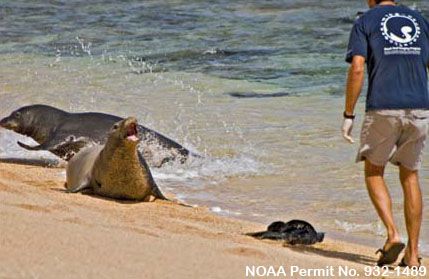
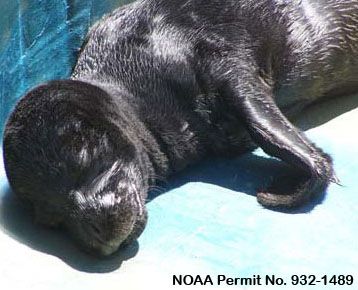
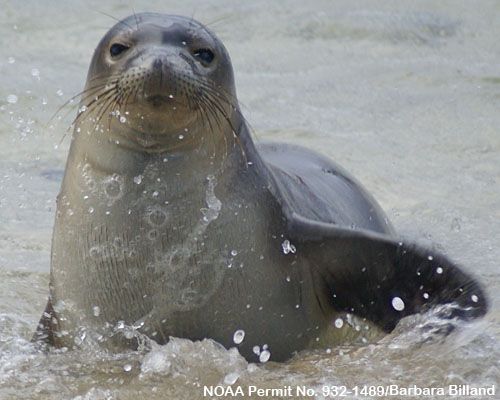
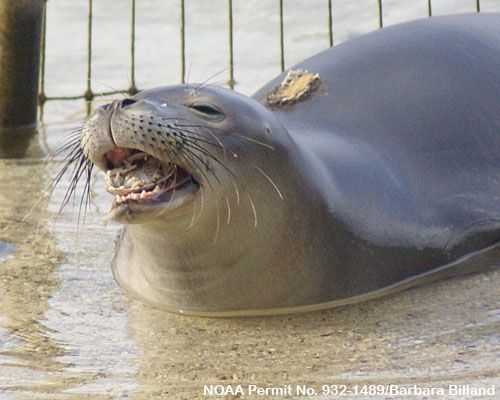
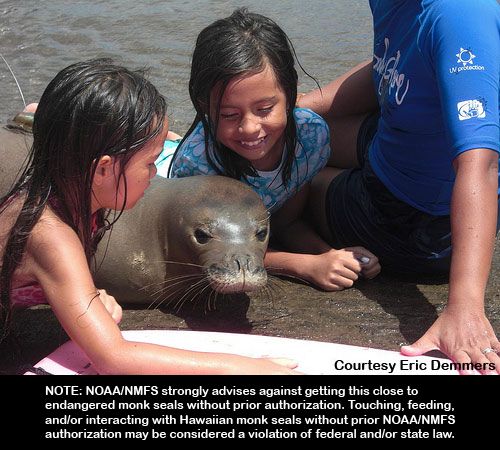
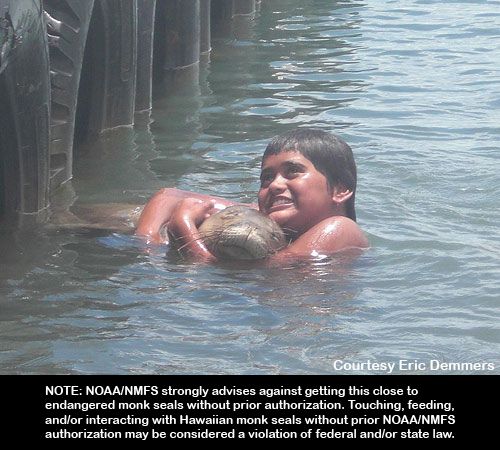
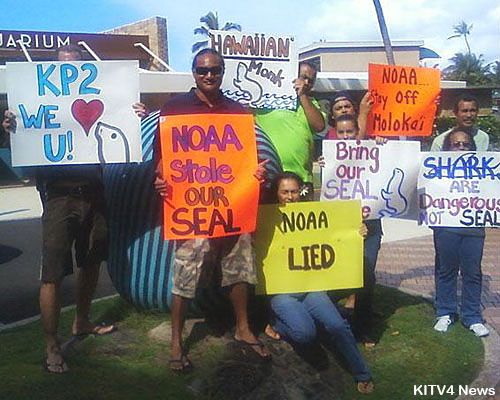
Not all human-seal conflicts in the main Hawaiian Islands end with a dead seal. Sometimes, conflict erupts over the animal itself. That was the case with a young seal named KP2. His story offers a unique look into the risks of raising animals in captivity and releasing them into the wild and unforeseen consequences that species preservation sometimes creates.
KP2, short for Kauai Pup Two, was born May 1, 2008 on a remote section of North Larsen Beach, Kauai. When NOAA veterinarian and volunteer coordinator Mimi Olry first saw him, he was alone, trying to draw milk from rocks and vocalizing loudly. His mother, RK22, was nowhere to be seen.
A year earlier, RK22 had given birth to her first pup, a female. At that time, RK22 showed no interest in her pup, even when the newborn cried out for her. NOAA officials tried desperately to get mom and pup together. They placed the pup within visual range of RK22, but she swam away. They tried again. Nothing. By the fifth day NOAA took the pup and gave her an examination. She was emaciated and weak. The only humane thing left to do, they concluded, was to euthanize the pup.
A year later it was happening all over again. And this time the instructions to Olry from her bosses were very clear. Give the mother and pup a day to reunite. If that fails, rescue him.
When RK22 returned to KP2, she wasn’t alone — two male monk seals were right behind her.
Mothers nurse pups alone. Pregnant females gorge themselves in the weeks before giving birth, and then spend six weeks nursing their newborns and transferring all their nutrients to them. They never leave their side, not even to eat. By week six, the mothers–starving and weak–head out to sea and do not return. The mother-pup bond is broken forever. Fathers play no role. (VIDEO: Get a look at a new pup born on Kauai in December 2009)
Adult Hawaiian monk seals do not live in colonies like sea lions or walruses. They are, as their name suggests, solitary creatures. Males are known to fight to mate with a female and this may account for the two males flanking RK22 that first day in May.
The males approached the pup and nipped at it. Normally, seal mothers are fiercely protective of their pups and will bite seals or humans who get to close, but RK22 did nothing to defend KP2.
Olry and staff separated the males from the mother and relocated KP2 next to her. RK22 approached the pup. Instead of showing him her teats to offer milk, however, she bit KP2 on the head and tossed him to the side.
At that point, Olry called for backup. Veterinarian Greg Levine, working on contract with NOAA, got word on Oahu, and quickly hopped a ride on a Coast Guard helicopter to Kauai.
When Levine reached the beach and attempted to retrieve the pup, RK22 vocalized at him with a loud “BWAAAAAAAAAAH.” He waited. Eventually the mother moved away and Levine took the pup to Olry.
NOAA had just adopted their first ever day-old baby monk seal. (PHOTOS: See KP2’s life in photos)
When there are only 1,100 members of a species left, every animal counts. In 2007, following the death of KP2’s sister, NOAA decided that in future cases of infant abandonment, it needed to step in and try to save the pups. From a scientific perspective, there was much to be gained. They could learn more about the health of young monk seals, and perhaps that information could be applied to save more of them in the Northwest Hawaiian Islands, where infant seals are dying at an alarming rate, according to the recovery report.
The rehabilitation of Hawaiian monk seals wasn’t entirely new for NOAA. They often find malnourished yearlings and help them gain weight before releasing them back into the wild.
But KP2 was different. KP2 was a newborn. KP2 would need around-the-clock care and handling by humans for months. Moreover, raising a wild animal in captivity with the intention of releasing it back into the wild is fraught with uncertainty and unintended outcomes, as NOAA would soon learn.
When KP2 arrived at Kewalo Research Facility on Oahu with Levine, he weighed about 25 pounds. His eyes were bright and alert. He demonstrated normal reflexes and had no trouble vocalizing. Biologists describe the sounds monk seals make as vocalizing. Adults make deep bellows – BWAAAAH! Pups make high-pitched BWAAAP sounds.
Levine’s first challenge was to get KP2 to eat. But what, and how? Levine called up the Marine Mammal Center in Sausalito, California, a hospital that treats sick and injured pinnipeds from up and down the Pacific coast – mostly sea lions, elephant seals, harbor seals and northern fur seals. Dr. Frances Gulland, the center’s chief veterinarian, has successfully hand-reared harbor seals for years. Together, Gulland and Levine came up with a modified harbor seal formula that consisted of electrolytes, fish oil and herring pureed into a mash. Levine had to force-feed KP2. The mash was placed in a large syringe that had a long tube on the end. One person held the seal while another person inserted the tube down its throat, then squirted the mash into its belly.
The first week was rough, Levine recalls. KP2 developed constipation but by day 14, the pup began to show improvement. Levine wanted KP2 eating fish as soon as possible. In the wild, monk seals wean for six weeks. In captivity, that time frame would expose KP2 to humans for far too long. They tried accelerating the weaning process by placing a cold thawed fish in his mouth. “He didn’t go for that,” says Levine. So he tried live fish and made it irresistible – moi. Moi is a Hawaiian fish that was reserved for royalty. Moi do very well in the fishponds of Hawaii. Levine found a fishpond willing to donate some moi for KP2. That did the trick, says Levine.
KP2 would swim around his enclosure at Kewalo, chasing the moi to tire them out. He would use his flipper to create a wave and wash them onto the deck. Then he would grab them with his mouth in a playful manner and spit them back in the pool. By the end of July, he was eating about 20 live fish a day and weighed around 44 pounds.
At 12 weeks, Levine started to think that if KP2 was eating live fish and swimming and growing at a normal rate, “we should be thinking about releasing him into the wild,” he says. Shortly after that conversation, however, Levine’s team noticed a problem. KP2 had developed mild cataracts. Cataracts are a clouding of the eye that obstructs the passage of light, and this could affect KP2’s survival in the wild.
Monk seals use a combination of senses to forage for food. Their highly sensitive whiskers help them detect fish movements in water. They can dive to a depth of 300 feet and traverse the sea floor turning over rocks with their snout. When an eel, octopus or lobster pops out, they’ll snatch it. To dive that deep, where it is very dark, seals must have extremely good eyesight.
Levine debated the cause. Was it the chemicals they were using to clean the pool? Was there too much light reflecting from it?. Was it congenital? Perhaps KP2’s mom knew something when she gave birth and abandoned the pup because she sensed something was wrong with him. But Levine couldn’t find anything to indicate the seal had a pre-existing condition. “We also ruled out infectious disease,” he says. It was likely a combination of environmental factors. How to solve it? Get him out of the pool and into a natural setting.
In early September 2008, NOAA moved KP2 to a shoreline pen at Marine Corps Base in Kaneohe Bay on Oahu. His round-the-clock care stretched the staff thin, so they called up D. B. Dunlap’s friends Barbara and Robert Billand to see if they could help out. Could they? “Hell, yeah,” says Barbara Billand.
The couple worked four-hour shifts, two or three times a week for three months. They sat at a table hidden from the seal by palm fronds. They took notes, watching to see when he would poop, pee, throw up, if he ate his fish, how many he’d eat, and so on.
And how did he behave? “More like a Labrador puppy than a monk seal,” Barbara Billand recalls. (PHOTOS: See KP2 in his shoreline pen)
It was around that time, Billand suspects, that KP2 began to develop a close connection to humans. “When people would arrive, he’d hear the car doors,” she says. “No matter what sound, he would hear it and look up and be real alert. Like he knew someone was coming. He’d scoot up to the fence and look and look.” She says he also began to recognize human voices.
The pen was great for KP2, bringing him a step closer to being in the wild. He got better and better at catching fish and slowly his eye problem stabilized. Levine checked his eyes once a day and had an ophthalmologist check him out once a week. Despite some permanent scarring, he was successfully foraging for fish and showing normal behavior.
By late November, veterinarians gave KP2 a clean bill of health and readied him for release. The next question was: Where?
Just twenty-six miles from Oahu is the small island of Molokai. On the north side of Molokai is a jutting outcrop of sea cliffs surrounded by lush valleys and dense rainforest called Kalaupapa. The area is a national park, providing native habitat for endangered Hawaiian monk seals attracted to the offshore islands and coral reefs. NOAA felt this area was ideal for KP2, in part because he was certain to run into other monk seals, which was crucial to his normal development.
On December 15, 2008, after eight months of captive care, KP2 was placed in a crate and flown by Coast Guard helicopter to Kalaupapa.
Caretakers took KP2 down to the water’s edge and opened the crate. He entered the water without so much as a backward glance, his caretakers reported. He spent about 3 hours playing and foraging in tide pools before heading out to deeper water in a protected cove where he was seen diving, foraging, and eating.
For two weeks, NOAA experts monitored him closely. At one point, they observed KP2 and another monk seal mock-fighting and rolling around together in the water. It was just the kind of behavior they’d hoped to see.
As the days passed, KP2 began to explore his new home, venturing further from the isolated beaches of Kalaupapa. In February, he swam into Kaunakakai Wharf, the island’s main commercial and ferryboat hub. The busy harbor is located across the main highway from the island’s main city of Kaunakakai. He spotted some kids playing in the water. He must have liked what he saw. The little seal swam over to the children and joined them in their play.
Word spread fast that a “tame seal” had turned up at Kaunakakai Wharf. When Molokai resident Alona Demmers heard the news, she grabbed her kids and some neighbors’ kids and headed for the harbor. “I saw his head pop up next to a couple of kids in the water, so I immediately jumped in,” she says. To get his attention, the kids told her to grab their pink boogie board. “That was the ice breaker,” she says. KP2 swam over to her and hopped on the board.
Demmers says KP2 would rub up against swimmers. “He would wrap his flippers around you. It was like he was hugging you,” she says. There was one particular kid KP2 seemed very bonded to. An 11-year-old boy named Kahi. Demmers says he would follow Kahi everywhere. “You could tell he liked him. They played rough a little bit, and I think KP2 enjoyed playing rough.” (PHOTOS: See KP2 swimming with people in Kaunakakai Wharf)
Monk seal-human bonding has happened before in the main Hawaiian Islands. There are areas on Maui and the Big Island where animals are born in isolation. A seal will wean and then be alone and can’t find other seals for interaction to develop. They find the next best thing — humans. “When an animal is a tiny cute seal wanting to play with you in the water, it’s a pretty tough thing to resist,” says Littnan.
To members of the public, this offers a rare encounter with wildlife; to biologists and wildlife officials, it’s a potentially dangerous turn in the development of a young animal. Juvenile seals like KP2 need social structure, Littnan explains. They need to play-fight and forage as part of the maturing process. NOAA wanted KP2 to learn those skills among the seals of Kalaupapa. Instead, he was playing and foraging with humans at Kaunakakai Wharf. “He got so much positive feedback,” says Littnan.
When NOAA officials found out KP2 was playing with children and adults at Kaunakakai Wharf, they were worried. NOAA strongly discourages people from swimming with monk seals. First, it violates the laws that protect them — the Endangered Species Act and the Marine Mammal Act. Second, there is a potential for serious injury.
“We’ve had experiences before where a 300-pound animal is just looking to play and then starts holding people underwater for too long,” Wende Goo, a spokesperson for the NOAA, told the Wall Street Journal in September 2009. “And with how much KP2 likes being around people, we think he’s bound to get to that point.”
But there was also concern for the seal’s safety.
The majority of Molokai’s residents welcomed KP2, but not the fishermen. “The reaction was really negative,” says Walter Ritte.
Demmers heard fishermen were threatening to harm the seal, and that’s when she decided to join NOAA volunteers who had come down to the wharf to keep an eye on him.
Early one morning, Demmers witnessed a local fisherman kick KP2 twice in attempt to get the seal to move off the dock. KP2 was blocking his path and he wanted him to move, she says. But KP2 didn’t move. The seal just looked confused, as if he didn’t know how to react. “He had no fear of humans,” says Demmers.
The more KP2 popped up in the harbor, the more he polarized the community and crystallized the challenges of protecting monk seals. Fishermen hated him. Locals rallied to his cause, adopting him as the island mascot. For Ritte, KP2 was a glimmer of hope, a force of positive change. Given time and education, Ritte believed, the seal and community, fishermen included, could learn to coexist.
But NOAA officials saw an endangered animal possibly endangering others.
NOAA viewed KP2 as a wild animal, not a pet. They appealed to the community at local meetings and at schools, asking that people stop swimming with the seal. Without human interaction he’d likely leave. But the campaign didn’t work. Local residents kept swimming with him.
The turning point occurred in September. A 70-year-old woman had entered the water and was playing with KP2 when the seal came up from behind and pulled her underwater for about 5 seconds. Fearing something far worse could happen in the near future, NOAA informed the community that it would be removing KP2 by the end of October.
“It was a foregone conclusion that, for his welfare and safety and primarily to make sure that he was going to be a normal functioning part of the seal community, he was going to have to be moved,” says Littnan.
NOAA’s decision outraged the community. “That really got me mad,” Ritte says. “I was pissed. NOAA takes a position that KP2 is dangerous. And they kept saying it over and over. It got into the press. People began to believe that monk seals were dangerous.” This was exactly what the fishermen wanted to hear, Ritte says. “Now not only were they stealing their fish, now they are dangerous and dangerous to our kids! They’ll kill them.”
At a community meeting, residents debated NOAA’s decision.
Demmers brought up the question: “If this animal ends up hurting a child, who is ultimately responsible? In unison, three people responded, ‘The parents.’ Then someone in the group said, ‘You know that’s not true. You know they are going to kill that seal. They are going to blame him for hurting someone'” says Demmers.
Early on the morning of October 16, NOAA staff captured KP2 and placed him in a crate. He was loaded on a truck and flown by Coast Guard helicopter back to Honolulu.
KP2 was taken to Waikiki Aquarium on Oahu to undergo a thorough medical exam. His cataracts had returned, and his vision had deteriorated. The vet staff estimated the seal was now 80 percent blind. He was compromised, says Littnan. KP2 would not be going back into the wild.
Back on Molokai, KP2’s outraged supporters wrote Hawaii State Representative Mazie Hirono, charging that NOAA had stolen their seal and they wanted him back.
Ritte organized a group that flew over to Oahu and protested outside the aquarium. Every local media outlet covered the story. Protesters carried signs that stated: “NOAA Stole Our Seal,” and “Sharks Are Dangerous, Not Seals.” It was a media relations debacle for the federal agency. Ritte accused NOAA of “bullying, lies and covert actions,” of failing to give his community respect and not working with them to find a solution they could all live with.
For its part, NOAA maintains it never lied to the community and acted in the best interest of the seal.
David Schofield, NOAA’s Marine Mammal Response Coordinator, told a Honolulu television station KITV that since July, NOAA representatives had visited Molokai schools and clubs repeatedly asking people to stop swimming with KP2.
“We explained that if you stopped the interaction with the seal, he would eventually go away. … However, the interaction with the seal continued,” Schofield told KITV. And now that he was nearly blind, he wasn’t even going back into the wild. KP2 would have to live the rest of his life in captivity. But where? The Waikiki Aquarium had its hands full with two adult male monk seals. Sea Life Park, also on Oahu, had four, two males, two females and limited space.
Ritte had an idea. How about the fishponds on Molokai? Molokai has thirteenth century fishponds, or loko i’a, that are still in use today, testament to native Hawaiians’ exceptional skills at practicing sophisticated aquaculture. Ritte takes care of a 60 acre loko i’a – couldn’t KP2 live there?
NOAA rejected the idea, saying it would be far too expensive. Eventually, Sea Life Park agreed they could take KP2 – but first the facility needed to be expanded to accommodate him, a process that could take a year or more.
In the meantime, NOAA found a place for the seal at the Mammalian Physiology Lab at the University of California at Santa Cruz (UCSC).”It’s one of the best facilities that he could be sent to” says Littnan. “It allows us to maximize what we can learn from him before he goes to Sea Life Park.” He won’t be a lab rat, Littnan insists. “He will have the choice to participate or not in behavior type experiments. They are not invasive.” And what about his eyes? Cataract surgery is possible, he says. But he’ll be evaluated first.
“When I heard KP2 was coming to Oahu’s Waikiki Aquarium, I had a hat made,” says Barbara Billand. The brown baseball cap has the outline of a monk seal with “KP2” written inside it. She and her husband again volunteered to help watch over him. This time the couple got really close to KP2. He would come right up to them like a puppy. “Your heart would melt. If you extended your hand and touched his back, he’d flip over and he’d let you rub his belly,” she smiles. “He was just a sweetheart,” Billand says, her voice cracking. (VIDEO: Barbara Billand watches over monks seals Kermit and Irma on White Plains Beach, Oahu)
The Molokai community made sure KP2 got a proper Hawaiian send off before his transfer to California. They held a traditional blessing for the seal at the Waikiki Aquarium. The residents asked NOAA to join them.
Standing outside KP2’s tank, the Reverend David Kaupu sent the seal “mana”–the power of the ancestors, a power capable of lifting him to the rank of the gods among mortals.
A traditional lai was tied on KP2’s tank. Kahi, the young boy who swam with him at the wharf, leaned over the tank and talked to him. The seal responded by splashing water.
KP2 was given his Hawaiian name, Ho’ailona, which means the chosen one. For the people of Molokai, the name ties them to him.
The blessing helped end much of the squabbling between NOAA and the Molokai community. To save the species, they vowed to find a way to work together.
On November 24, 2009 Ho’ailona left Hawaii in a military plane for Santa Cruz. (Read Chapter 6)